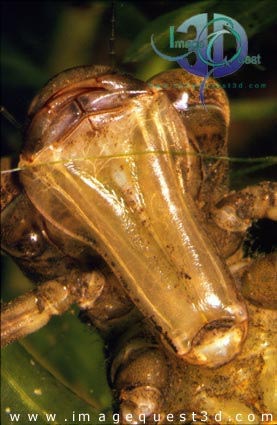|
Dragonfly Nymph
©
2000 by Image Quest 3-D
Read our copyright notice
Photograph by Peter Parks Dragonflies, Order Odonata, are amongst the largest and most conspicuous of British insects, and are familiar creatures around freshwater. They are instantly recognized by their fast, whirring flight and often vivid colouration - red, yellow or metallic blue or green. Although in the past they have been attributed with various sinister abilities they are harmless to man - they cannot sting - and their diet, which includes many noxious insects such as mosquitoes and biting midges, must be positively beneficial. They hunt entirely by sight, using enormous compound eyes. Following courtship and mating 'on the wing', dragonflies deposit their eggs within or alongside freshwater vegetation. The eggs will hatch in two or three weeks into the nymph development stage, as seen here. The nymphs have an unusual looking hinged protrusible 'mask' that is used of prey capture. Nymphal life lasts from one to five years, depending on species and climate. Emergence, the final moult from nymph to winged adult, takes place out of water and usually during the night. The newly emerged insects are dull in colour and do not attain their full coloration for two or three weeks, at which time they also become sexually mature.
Click here to view the 'Picture of
the Week' archive.
|
||||||||
|
|
||||||||


